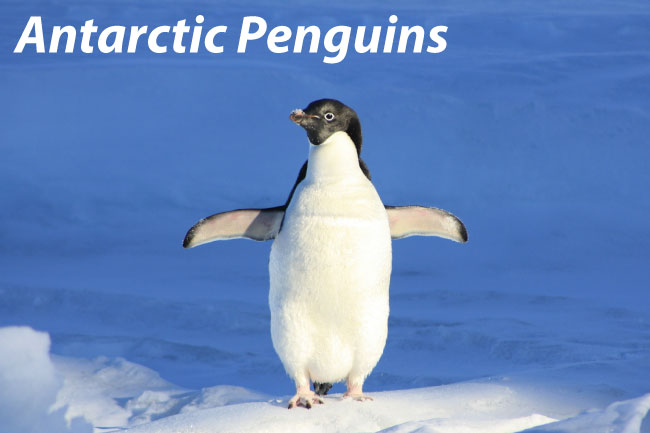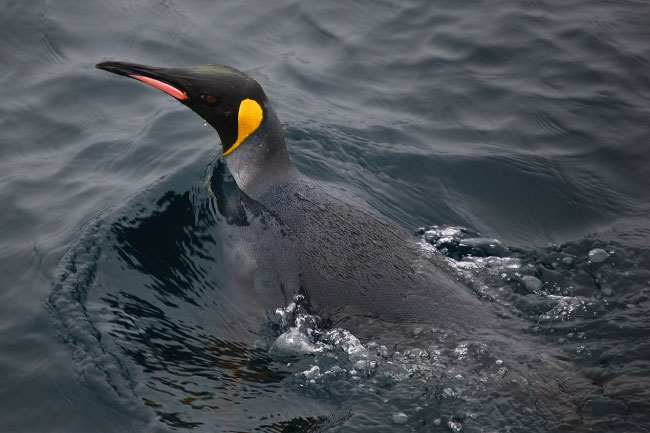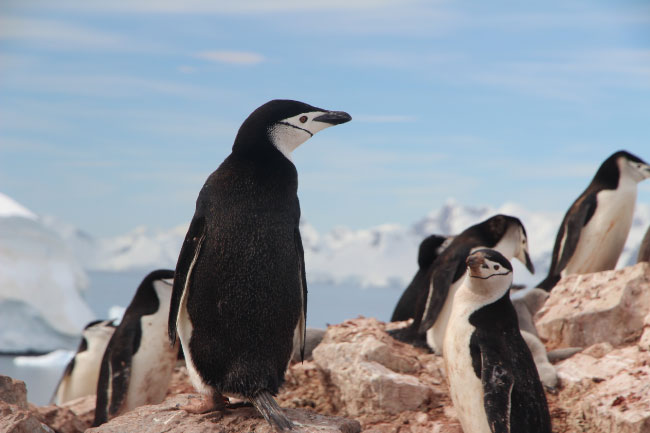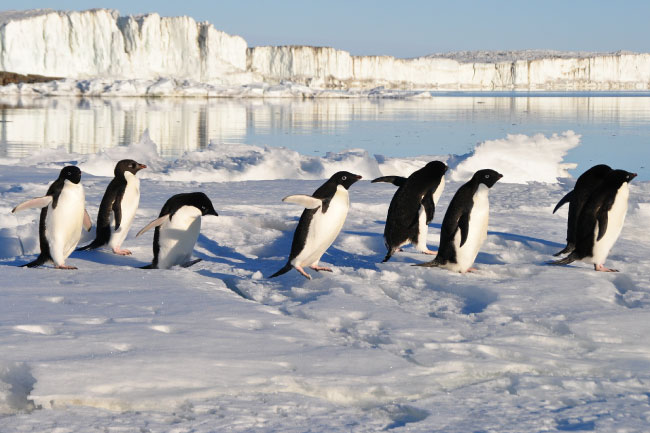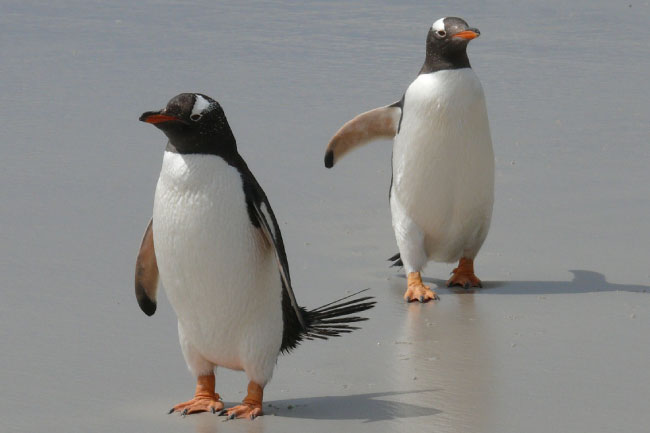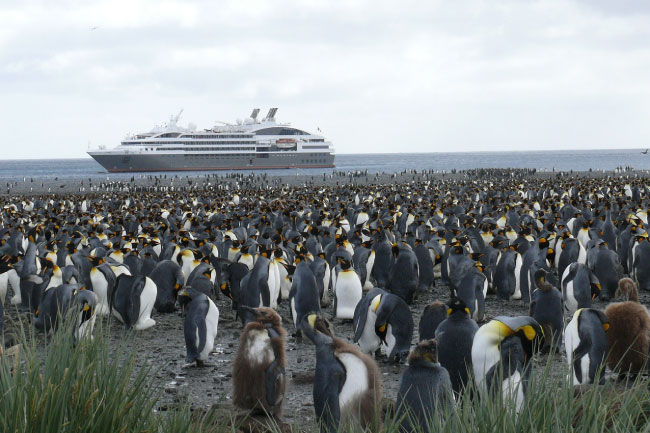On this page, we continue our Antarctica series by taking a look at Antarctic penguins. We'll cover the types of penguins in Antarctica itself, and we'll also find out about penguins in the surrounding Antarctic region.
- This article is part of our Antarctica series.
- You can discover more Antarctic wildlife here: Antarctic Animals.
- See a list of EVERY penguin here: Penguins Species List With Pictures & Facts
Antarctic Penguins: Introduction
They're among the world's best loved animals, and because penguins stand upright and look vaguely human they’re often portrayed as being rather comical.
In fact, penguins are highly specialised hunters, able to survive in some of the world’s harshest environments.
Very few animals other than penguins are able to make a home either in the Antarctic region or on the frozen continent of Antarctica itself.
- You can find out more about penguins here: Penguin Facts.
On this page we’ll find out about the five species of penguin that breed on the continent of Antarctica. Then we'll look at some more penguins found in or near the Antarctic region.
Let’s learn more about Antarctic Penguins …
Penguins In Antarctica
Five species of penguin breed in Antarctica. They are the Adelie, Chinstrap, Emperor, Gentoo, and Macaroni penguin.
On this page we'll look at each of these penguins in more detail. We'll then find out about other Antarctic and subantarctic penguins.
The ‘Conservation Status’ gradings are from the IUCN Red List. You can learn more about what these mean here: Endangered Animals Facts.
Emperor Penguin (Aptenodytes forsteri)
The Emperor Penguin is the world’s biggest penguin. It grows to around 122 cm (48 in) tall. It is only found in Antarctica (i.e. it is endemic to the continent).
The Emperor Penguin is the only species of penguin that breeds during the Antarctic winter. This allows its chicks to grow in the (slightly) warmer summer months.
In the winter Emperor Penguins huddle together for warmth in huge colonies.
- Conservation status: Near Threatened
You can see a colony of Emperor Penguins in the incredible video below:
You can find out more about these amazing birds here: Emperor Penguin Facts
Chinstrap Penguin (Pygoscelis antarctica)
The Chinstrap Penguin is easily identified by the ‘strap’ of black under its bill. Although one of the five penguin species that breeds on Antarctica, the Chinstrap Penguin also breeds in Argentina, Chile, the Falkland Islands, and several other regions.
- Conservation status: Least Concern
Adélie Penguin (Pygoscelis adeliae)
The Adélie Penguin is found further south than any other species of penguin. It is named after 'Adélie Land', a part of Antarctica which was itself named after a French explorer’s wife.
In the breeding season, Adélie Penguins form colonies that number over half a million birds. They are medium-sized penguins, recognisable by a white ring around their eyes.
- Conservation status: Near Threatened
Gentoo Penguin (Pygoscelis papua)
You can tell a Gentoo Penguin by its white 'eyebrows'. Like most penguins it has a white chest and a black back. This breaks up its outline while swimming and protects it from predators. Gentoo penguins have longer tails than other penguins.
The Gentoo Penguin breeds in several southerly locations, including Antarctic islands and the Antarctic Peninsula of Antarctica. It is the 3rd largest penguin.
- Conservation status: Near Threatened
You can see amazing footage of Gentoo Penguins (and the beautiful Antarctic landscape) in the video below:
Macaroni Penguin (Eudyptes chrysolophus)
The Macaroni Penguin can be found on the Antarctic Peninsula and several other Antarctic and Subantarctic locations. It is easily recognised by its bright yellow crest.
Although the Macaroni Penguin is the most common of all penguins, with a global population of around 18 million, its numbers are declining. It is now rated as ‘Vulnerable’ on the IUCN Red List.
- Conservation status: Vulnerable
Other Penguin Species
Although they don't breed on Antarctica, the King Penguin and Rockhopper penguin are found in the Antarctic region within the Antarctic Convergence.
King Penguin (Aptenodytes patagonicus)
The King Penguin is the second largest species of penguin. It can grow up to a metre (3.28 ft.) tall. It is recognisable by its orange ‘headphones’ and bill, and the faint orange markings at the top of its chest.
There are two subspecies of King Penguin: Aptenodytes patagonicus patagonicus and Aptenodytes patagonicus halli. Both are found in the northernmost parts of the Antarctic region.
Conservation status: Least Concern
Southern Rockhopper Penguin (Eudyptes chrysocome)
The Southern Rockhopper Penguin is one of the smallest penguins, standing at around 50 cm (20 in) tall. It has bright red eyes, a red beak, and spiky black and yellow feathers of its head.
There are two (possibly three!) subspecies of Rockhopper penguin. The Southern Rockhopper Penguin is found on northern Antarctic islands, as well as in several subantarctic locations. Northern Rockhopper Penguins are found further north.
- Conservation status: Vulnerable
- (Northern Rockhopper Penguin: Endangered)
Antarctic Penguins: Conclusion
We hope that you've enjoyed learning about Antarctic Penguins.
Now you’ve found out about the penguins in Antarctica, you can discover even more of the region’s incredible wildlife here: Antarctic Animals List.
If you want to find out about the world’s polar regions, take a look at these pages:
- Discover the frozen oceans and rocky tundra around the North Pole: Arctic Facts.
- Find out more about the frozen continent at the southernmost part of the world: Antarctic Facts.

